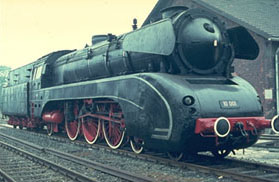Epoch III
Introduction
A new start
The first trains after the war
The first network of long-distance trains
Moving forward, more trains, more comfort, more regularity
Pre war rolling stock again in service
The start of an international long-distance network
The blue network of fast express trains
The modern era, the rise of electric locomotives
The modern diesel locomotive is coming
A new class of coaches
The third class is abandoned
The last new steam engine
A new prestious network, the Trans Europ Express
The Rheingold, from 1962 again exclusive
A new star on rails, the electric locomotive E 03
The last new steam engine
In the fifties the DB wanted to built a new class of steam engines to replace the old DRG steam engines. They thought at the beginning of the fifties that due to the risen of the number of passengertrains there was more need for fast express train steam engines.
The BR 10 had to replace the series 01.10 and 03.10. They wanted to replace these steam engines by a powerful and lightweight 1'C1'h2 steam engine. They had to comply with an exact performance program which was laid down. For example they required that the locomotive had an axle load of 20 ton and a maximum speed of 130 km/u.
In 1950 the HVB in Offenbach instructed the Eisenbahnzentralamt (EZA) in Göttingen to design a new steam engine. Already August 1950 the EZA presented together with the German locomotive industry the first proposals. The presented steam engine was able to pull a train of 420 ton with a speed of 130 km/h on a flat land.
In September 1950 the HVB asked for a new design. The locomotive, in the meantime indicated as BR 10, had finally a total weight of 66 ton and an axle load of 22 ton. Also the German locomotive industry brought forward new proposals for the new steam engine, but finally they chose for the design of the EZA.
Ultimatelythe steam engines were built as three cylinder engines with driving wheels of 2000 mm diameter. Also the steam engines got an axle arrangement of 2'C1' instead of 1'C1'. Due to the high axle load of 22 ton, this reduced the lines were they had service, because not all lines were able to run at speeds of 140 km/h.
The steam engines BR 10 were semi streamlined. The streamline plates enclosed the cylinders, which were reachable by covers which could be folded. The streamline plates were painted with elegant lines. The smoke box door was conical shaped.
 | | BR 10 001 at the steam engine museum Neuenmarkt-Wirsberg | Photo: Christian Splittgerber |
In 1956 Krupp delivered the 10 001 and in January 1957 they delivered the 10 002. Both steam engines were oil burned. The two steam engines BR 10 went into service in March 1958 from the Bw Bebra, from where they had their service on the "Nord-Süd Strecke" on the relations Hannover, Kassel and Frankfurt (Main). Mainly due to the ongoing electrifying of the mainlines, the two locomotives were moved in 1962 to the Bw Kassel.
After all only these two locomotives are built because due to the modernising of the railways there was no need any longer for this sort of steam engines. Due to damage to the driving wheels and the shrinkage of their service area the 10 002 was first taken out of service in January 1967, a year later followed by the 10 001.
The express train locomotives class BR 10 were the first (and last) new developed steam engines of the new Deutsche Bundesbahn.
Afterwards the need for steam engines decreased quickly caused by the ongoing electrifying of mainlines and the purchase of new modern diesel locomotives by the DB. This were all developments were nobody was aware of at the beginning of the fifties.
|
